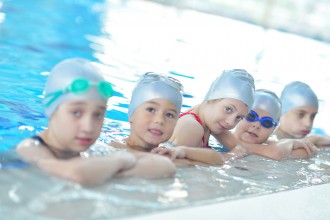Swim Lessons Limited in NM Despite High Drowning Rate: Young children at greatest risk
Swim Lessons Limited in NM Despite High Drowning Rate: Young children at greatest risk
March 18, 2025By AUTUMN GRAY

Despite the fact that New Mexico is a landlocked desert state, its drowning rate is 24% higher than that nationally, ranking us 11th in the country for unintentional drowning deaths, according to the most recent (2024) data from the Centers for Disease Control. Nationally, drownings are at five-year high - 4,500 people annually - with young children and older adults impacted the most. However, such deaths are preventable, and now is the best time of year to take action to protect your family.
Not surprisingly, swimming lessons are one of the best ways to lower the risk of drownings and save lives. However, a recent survey conducted by The Harris Poll for the Pool & Hot Tub Alliance and Step Into Swim found that 48% of parents of children 14 and younger were not aware of places that offer local swimming lessons; a whopping 83% of that same group were confident their children could be safe around water; and 66 percent of respondents said they believed floaties or water wings were sufficient to keep children safe in water.
“It only takes a teaspoon of water to drown, depending on how it gets into your system and blocks your airways,” said Brian J. Stinett, City of Santa Fe Recreation Division director. “Drowning can occur anywhere, including in bathtubs.” Lakes, arroyos, non-lifeguarded bodies of water, in-home pools, hot tubs, and bath tubs are all local drown risks, he said.
The best precaution, Stinett said, is to learn to swim early – as young as age 1 – and if you never took lessons as a child, realize it’s never too late. Stinett also advises that Northern New Mexicans wanting to enroll their children in swim classes shouldn’t wait.
“It behooves parents to start looking as soon as they see this article,” he said. “There’s a massive push for (municipal) swim lessons. It’s almost a first-come, first-served so that a lot of people can’t get in. We expect a large contingent to soak up those spots.”
Once a parent has decided to enroll their child in lessons, the biggest choice is whether to place them in group or individual classes. Private lessons are beneficial due to the one-on-one attention they afford, but they aren’t always the best option and they’re more expensive. Some children thrive in a group lesson where they have the ability to see others learning; some find the group dynamic distracting. Experts suggest trial and error to see what best suits your child, noting that rapport with the instructor is also critical.
“That’s important, especially for younger kids, because if a child can really trust the person and feel safer and have more fun, it becomes a lot easier to get a lot done versus just having a transactional relationship,” said Matt Steiger, owner of 505 Swimming.
Recognizing that demand is greater than the Recreation Department’s resources, Stinett said the City of Santa Fe has recently begun partnering with private swim lesson organizations, allowing them to use City facilities for their programs. Partnering companies include 505 Swimming, Charger Aquatics, Beast Aquatics, and Star Aquatics.
“New Mexico is underserved,” said Steiger of 505 Swimming, which serves Santa Fe and Los Alamos, and is seeking partnership in Albuquerque this year, too. “Three years ago (when he started the business), there was no coordinated effort to offer lessons in Santa Fe, no serious programs put together. What there had been was wiped out after the pandemic.”
Not only is access to swim lessons an issue for New Mexicans but so is awareness of the need for that knowledge. Because New Mexico has so little water and because so many people wrongly believe that most drownings occur in large bodies of water, the state has a large population that doesn’t know how to swim.
“A lot of parents who bring their children (for lessons) don’t know how to swim either,” Steiger said. “When a parent is afraid of the water, that can make it harder on the kid who is learning how to be safe in the water.”
Over half (55%) of U.S. adults have never taken a swimming lesson, the CDC states, and for Hispanics, the numbers are even higher: About three in four Hispanic adults (72%) reported never taking a swimming lesson.
Research has shown that the earlier a person becomes accustomed to being in the water, the better. At age 1 or 2, for example, a child is still adaptable and moldable, but by 6 or 7, it’s a lot less natural for them, Stinett said.
“It’s innate in humans where if you don’t learn to swim, you become afraid of it,” agreed Steiger. “Some people develop a mindset that they’ll never learn to swim.”
Statistically, children ages 4 and younger have the highest drowning rates in the U.S., with most of these deaths occurring in swimming pools, the CDC reports. In fact, more children ages 1-4 die from drowning than any other cause of death. For ages 5–14, drowning is the second leading cause of unintentional injury death (after motor vehicle crashes).
Adults 65 years of age and older have the second highest rate of drowning.
“Swimming is a life skill,” Stinett said. “You never know a time when you’re going to need it.”




